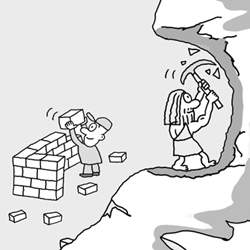In this Chapter:
- Introducing fullerenes, nanotubes and other mini-marvels
- Fullerenes
- Nanotubes
- Self Assembling Films
- Thin Films

A land whose stones are iron, and out of whose hills you can dig copper. - Moses, describing the material richness of the Promised Land, Deuteronomy 8:9
They sound like characters in a miniature fantasyland: fullerene, nanotube and quantum dot. But these and other nanosized particles may give rise to a host of real-life technologies.
Fullerenes are soccer-ball shaped molecules made of 60 carbon atoms, discovered in 1985 by Richard Smalley and colleagues at Houston’s Rice University. While commercial applications have been slow to materialize - primarily due to their high production costs - scientists believe that fullerenes may serve the basis for future insulators, semiconductors and novel drug delivery systems that might, thanks to their diminutive size, interact directly with target cells, proteins and viruses.
Nanotubes rolled onto the scene a few years later. Roughly one hundred times stronger than steel and able to withstand temperatures of up to 6,500 0 F, these cylinder-shaped carbon molecules are a promising material for diverse engineering targets, from electronics to ultrastrong lightweight cars, airplanes, ropes and fabrics.
And the quantum dot (QD), while still largely a laboratory curiosity, is a nanosized “box” that allows researchers to trap individual electrons and monitor their movements. Future applications might feature QDs in solid-state lasers emitting light at wavelengths never before achieved.
The immense potential of these tiny materials lies in the nano niche they occupy, where the classical Newtonian laws of physics play second fiddle to quantum phenomena. On this scale, electrons and other sub-atomic particles can act as either waves or particles, allowing them to pull off such surprising feats as being in two places at the same time and traveling through otherwise imper-meable layers in a semiconductor. Taking advantage of the electron’s dual nature, future computers might have quantum bits capable of existing simultaneously in the 0 or 1 state (the language used by computers to represent information), thus dramatically fast-forwarding information processing.
Another important property of nanoscopic structures emerges from their high surface-to-volume ratio: as structures get smaller, the percentage of their atoms located at or near the surface increases. This feature has major implications since so many of the interactions occurring in the material or biological world take place at the surface (such as immune responses triggered by the surface-borne antigens carried by invading foes).
Collectively, future devices made of nano-materials will be aimed at cashing in on the unique behavior of electrons in a quantum setting to usher in some of the coveted goals of miniaturization: better, faster, cheaper.
They sound like characters in a miniature fantasyland: fullerene, nanotube and quantum dot. But these and other nanosized particles may give rise to a host of real-life technologies.
Fullerenes are soccer-ball shaped molecules made of 60 carbon atoms, discovered in 1985 by Richard Smalley and colleagues at Houston’s Rice University. While commercial applications have been slow to materialize - primarily due to their high production costs - scientists believe that fullerenes may serve the basis for future insulators, semiconductors and novel drug delivery systems that might, thanks to their diminutive size, interact directly with target cells, proteins and viruses.
Nanotubes rolled onto the scene a few years later. Roughly one hundred times stronger than steel and able to withstand temperatures of up to 6,500 0 F, these cylinder-shaped carbon molecules are a promising material for diverse engineering targets, from electronics to ultrastrong lightweight cars, airplanes, ropes and fabrics.
And the quantum dot (QD), while still largely a laboratory curiosity, is a nanosized “box” that allows researchers to trap individual electrons and monitor their movements. Future applications might feature QDs in solid-state lasers emitting light at wavelengths never before achieved.
The immense potential of these tiny materials lies in the nano niche they occupy, where the classical Newtonian laws of physics play second fiddle to quantum phenomena. On this scale, electrons and other sub-atomic particles can act as either waves or particles, allowing them to pull off such surprising feats as being in two places at the same time and traveling through otherwise imper-meable layers in a semiconductor. Taking advantage of the electron’s dual nature, future computers might have quantum bits capable of existing simultaneously in the 0 or 1 state (the language used by computers to represent information), thus dramatically fast-forwarding information processing.
Another important property of nanoscopic structures emerges from their high surface-to-volume ratio: as structures get smaller, the percentage of their atoms located at or near the surface increases. This feature has major implications since so many of the interactions occurring in the material or biological world take place at the surface (such as immune responses triggered by the surface-borne antigens carried by invading foes).
Collectively, future devices made of nano-materials will be aimed at cashing in on the unique behavior of electrons in a quantum setting to usher in some of the coveted goals of miniaturization: better, faster, cheaper.






















